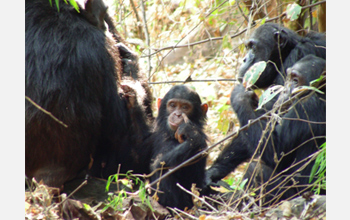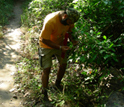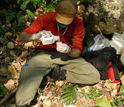|

Discovery
Researcher Walks Among Dying Baby Chimps

Virginia Tech scientist Taranjit Kaur describes her team's research studying chimpanzees in western Tanzania and the virus that is threatening the chimps’ health

Baby chimps are at an especially high mortality risk if they develop an upper respiratory infection.
Credit and Larger Version |
September 9, 2008
Editor's note: The author received a Faculty Early Career Development (CAREER) award from the National Science Foundation in 2003. CAREER awards are given to outstanding researchers in science and engineering who are near the beginning of their academic careers and are committed to integrating research and education. As the sun rises, my commute to work begins. There is no traffic at all to speak of except for a few baboons frolicking about and a couple warthogs at their favorite grazing spot for breakfast. I am at six degrees south of the equator and 30 degrees east of the prime meridian, where there is an enchanted forest, called Mahale Mountains. It is situated along the shores of a vast lake, Lake Tanganyika, in East Africa. Mahale Mountains National Park is a foot-walking park. It stretches across 623 square miles in a remote location in western Tanzania, East Africa. Mahale is very remote. The nearest town is between 10 to 12 hours by steamship. I come here to study the wild chimpanzees. They are habituated to human presence. Lucky to find them Each morning, I wake up and wonder where the chimpanzees are today--high up in the mountain range or lower and closer to my base camp. Trekking through the forest, I listen for their vocalizations. On a good day, I hear some vocalizing and can work towards finding them. A great day is one where I actually find them and can spend some time with them as they roam around in perfect liberty. I am humbled--their appearance and behavior command my respect. After all, chimpanzees are the closest living relative of humans. Less than about 2 percent of their DNA sequence differ ours. This close genetic relationship makes chimpanzees susceptible to many of the same diseases that we are susceptible to. I study chimpanzee health. I want to determine how and why they are getting sick and dying. Eco-friendly research I have developed a software program for this research. It enables me to collect data rapidly using a handheld computer. I can download the data automatically, directly into a database that I built. I need a reliable power source in the field, though, to run the system. Mahale is very remote and there is no source of power available. A gasoline-powered generator or solar power are the only options available. I decided to go all solar since I believe it is the most environmentally friendly approach. I needed a physical structure to work out of. I wanted my research station to be eco-friendly and leave the smallest possible footprint in the forest. So I worked with architects and engineers to design and develop my eco-friendly lab. Human disease For my research, I observe the chimpanzees. Also, I collect specimens for analysis. Research on chimpanzees here is "hands-off." I can only collect feces and urine, and saliva can sometimes be collected from leftover pieces of fruit that the chimpanzees were eating. Using samples collected from sick chimpanzees, I can do forensics of sorts. Following this approach, I was able to detect a virus in the feces. After doing further molecular analysis on the virus, I was able to tell that it was closely related to a human virus called the metapneumovirus. Metapneumovirus in humans causes acute respiratory disease. It can sometimes lead to death, most often in young children. Looking at my data, it was very clear that most of the chimpanzees that were getting sick and dying were the younger ones, as is the case with humans. Now, the question arises, how did the virus come to infect and cause disease in chimpanzees at Mahale? At this moment in time, it is very hard to answer this question. Currently, I am doing further research. Hopefully, I will be able to determine the origin of this human-related chimpanzee metapneumovirus that has been causing disease and death in chimpanzees at Mahale. The work goes on ... -- Taranjit Kaur, Virginia Tech taranjit@vt.edu This Behind the Scenes article was provided to LiveScience in partnership with the National Science Foundation.
Investigators
Taranjit Kaur
Jatinder Singh
Related Institutions/Organizations
Virginia-Maryland Regional College of Veterinary Medicine, Virginia Polytechnic Institute and State University
Locations
Virginia
Tanzania
Related Programs
Advances in Biological Informatics
Related Awards
#0238069 CAREER: Bridging the Gaps Using Field-To-Base Systems
Total Grants
$778,162
Related Websites
LiveScience.com: Animals: Researcher Walks Among Dying Baby Chimps: /news/longurl.cfm?id=128
LiveScience Video: Walk With the Mahale Chimpanzees: /news/longurl.cfm?id=129
Bush-to-Base Bioinformatics: http://www.bush2base.vt.edu/
|







